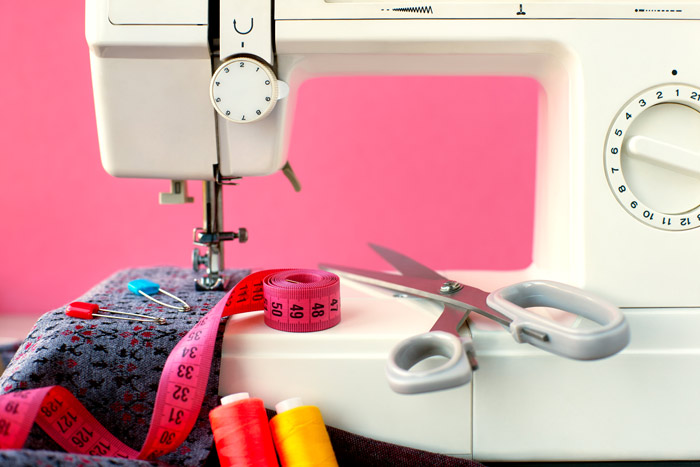 Whether you own a mechanical or an electric sewing machine, a handwheel is an important part of it.
Whether you own a mechanical or an electric sewing machine, a handwheel is an important part of it.
You might not be, however, involved directly with it if you have an automatic machine, but it still plays a major role, and going bad means you’re in some trouble.
So, you should always make it your priority to detect if it’s getting jammed or hard to turn and remedy the situation as soon as possible.
In this article, we will look at some of the potential reasons why it may be getting hard to turn and then see the solutions to the problems in a very easy way. So, make sure you give it a thorough read. Let’s start without any further ado.
Diagnosis is The Key!
Before you can start fixing the issue, it is important first to diagnose what’s causing it. Without this step, we cannot take proper precautions and come up with a solution.
So, below I will be mentioning all the possible problems and their solutions along with them.
1. Dust/Lint
This is the common issue faced by the DIYers or the people who use their sewing machines once in a while.
What happens is that they don’t really take care of their machine and clean it regularly, which helps the dust to build up and eventually become an obstacle in the way of handwheel movement.
Moreover, when you are continuously sewing without taking a break, lint can build up in the handwheel segment, keeping the wheel from swift movement.
So, the major thing to take from here is that these small issues might be causing big harm, and if you take proper care of your machine, these issues will never come up.
Solution
The solution to this is pretty straight-forward; you just need to keep your machine a bit tidy and make sure the dust doesn’t accumulate a lot on it.
And even if you don’t need to use it for long periods, take it out once in a while and clean it, that’s all.
On the contrary, if you are using the machine for long hours, you need to be aware of the lint; oiling and greasing the wheel regularly will take care of it.
2. Inner Knob is Tight
If you are not using a very modern machine, you can look inside the handwheel, and there’ll be a small knob that can be used to control the handwheel.
Turning this knob around can harden or soften the turning of the handwheel. So, there’s a chance you mistakenly moved this knob, and now the handwheel is not turning easily.
Solution
Nothing to worry about; just turn the knob around and use the hit-and-trial approach until the wheel turns easily enough. The knob can also be locked sometimes, at a certain angle, so make sure it’s not locked as well.
3. Upper Thread Tension
While you are sewing, the upper thread is sometimes tangled beneath the fabric, and there is no tension in the upper thread.
When this happens, many people who even have experience dealing with sewing machines think that there is something wrong with the bobbin. However, there isn’t anything wrong with it, and it is just the issue of the tension in the upper thread.
What happens is that the tension present is not enough to pull the thread through the cloth.
Solution
For this, you might need to rethread the needle again and get the tension up to a certain level.
If you aren’t an expert in the subject, you might need to refer to the instructions that came with the machine, which will have the information about the level of tension you need to set.
4. Belt
A broken belt could also be the reason why your handwheel is not functioning properly. However, this is a very apparent problem, and a broken belt will be readily visible, so you don’t need to check this especially.
Solution
To tackle this, there is no other way to replace the belt you have installed.
While you can order a belt online and change it yourself, it can sometimes be a bit tricky, so if you are new to sewing machines, I would recommend you get the help of a professional and ask him to replace it for you.
It might cost you a bit, but it will ensure your sewing machine does not get damaged.
5. Oiling
Sometimes, there is no problem with the handwheel, and the only reason it is becoming hard to move or getting jammed is the age.
Machines tend to get weary, and soon they start to face problems due to all the moving machinery involved. This is exactly what happens here, and all you can do about it is regular oil the moving parts.
Solution
Adding a little oil to the gears is all that’s needed. However, one thing you need to make sure of here is that you don’t add too much oil as it can cause its problems.
You should start with a single drop and start moving the handwheel. If it’s still jammed, you can gradually start increasing the quantity of oil you’re adding and stop when it’s going smoothly.
If your machine is pretty oil, you might need to do it quite frequently.
6. Incorrect Threading
This is a hard pill to swallow. Even the best of the sewers sometimes struggle with accurate threading, and when it poses a problem to the handwheel, they don’t think it could be their threading, which is causing the problem.
So, no matter how good you are at your job, there can sometimes be mistakes, which could lead to jamming of the handwheel.
Solution
Even if you don’t think this could be the problem causing the jamming of the handwheel, it doesn’t take long to analyze if the threading is not done accurately and doing it again if that’s the case.
So, always make sure you double-check this to rule out this possibility.
Conclusion
Sewing machines, especially the old ones, often face the issue of handwheel jamming, and frankly, it’s not a very big issue and just needs a bit of your attention to get solved.
We have covered all possible scenarios which could be causing the issue, so make sure you go through all of them to find the problem you are facing and then remedy it accordingly.
However, there is a possibility that none of these solutions fit for you. For such a scenario, it’s best to take the machine to a mechanic so he could look into it.
Read Also:

